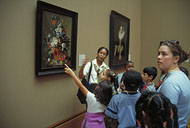Grades/Level: Lower Elementary (K–2), Upper Elementary (3–5), Middle School (6–8), High School (9–12) |
||||||
Activity Overview |
||||||
It's only natural for visitors to want to touch works of art. Usually, they don't realize that damage results when many individuals touch objects, even if they do it very gently. |
||||||
Learning Objectives |
||||||
Students repeatedly touch a piece of paper, and then examine it for evidence of dirt and damage to learn why they should not touch works of art. |
||||||
Materials |
||||||
• Two ordinary pieces of white paper, about 4 x 5 inches |
||||||
|
||||||
Activity Steps |
||||||
1. Take two pieces of ordinary white paper and pass one of them around the classroom. Ask each student to rub the piece of paper between his or her fingers for a moment before passing it along. |
|
|||||

